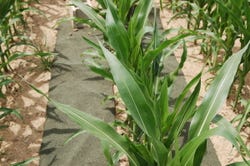April 23, 2015

Early-season corn and weeds don’t just compete; they also interact on a genetic level. Weeds grow bigger while corn plants grow less. Sharon Clay, professor of plant science, South Dakota State University (SDSU), used genetic mapping technologies to disclose what happens in the plant.
“Genes controlling response to light, production of chlorophyll and ability to convert raw materials into energy were decreased or down-regulated even before the expected impact of weed competition stress,” Clay says. “The critical weed-free period has been identified as when significant yield loss results. However, we found that even when corn plants are very small and there isn’t a significant yield loss, weeds create a cascade of effects on the genes that can impact yield later in the season if the plant comes under stress.”
Clay emphasizes that just as weed stress can no longer be limited to water, nutrient and light competition, other stresses appear to have a genetic response component. In other research at SDSU, early-season water stress also had a genetic response. It affected the corn plant’s immune response and its ability to take up phosphorous, as well as the cellular response to wounds and insect tolerance. As with the early-season weeds, the effect lasted the remainder of the growing season.
“Plants are sensitive organisms,” Clay says. “We assumed that if we took away the weeds, we would see up-regulation of the genes, but they never recovered. We don’t know what is going on at the DNA/RNA level. Cellular cross-talk is incredible.”
Clarence Swanton, professor of plant science, University of Guelph, Ontario, uses the term “plasticity” when explaining this potential for a plant to respond structurally and physiologically to environmental cues. While examining the impact of red to far-red light ratios on developing corn plants, he found that the structural response expected from light competition (stem elongation, apical dominance and variable leaf area distribution) develops before that competition actually occurs. Like Clay, Swanton’s research showed that once the changes occurred, they could not be undone. The growth rate and yield potential were altered for the life of the crop and limited the ability of the crop to respond to later stresses such as drought.

Using scraps of green AstroTurf, Mark Lawson, Syngenta agronomic service representative for Indiana, has demonstrated the impact of green weed light reflectance. Growth rate and yield response were affected for the life of the crop as well as the ability to respond to later stress. Photo: Syngenta
Mark Lawson, Syngenta agronomic service representative for Indiana, has been replicating Swanton’s findings in field plots. He has used AstroTurf to simulate green weed light reflectance.
“You can take $20 worth of cheap carpet and see for yourself,” Lawson says. “It drives home the importance of early-season weed control. Even when you kill the weeds after the crop has emerged, you don’t see a yield increase.”
Clay’s research on indicating a change in photosynthesis potential is an interesting addition to Lawson’s knowledge base. Lawson notes that the message related to weed interaction carries over to cover crop management and the importance of planting in “brown,” if not bare, soil. It also relates to problems with relying on post-application weed control.
For Lawson, the research by Clay and Swanton emphasizes the need for pre-emergence herbicides. “We thought we could let weeds grow and then spray,” Lawson says. “On average, that costs us about 9 bushels per acre. I think early reports of yield drag with the herbicide-tolerant trait may have been related to this impact. The bottom line is we don’t want weed competition.”
About the Author(s)
You May Also Like




